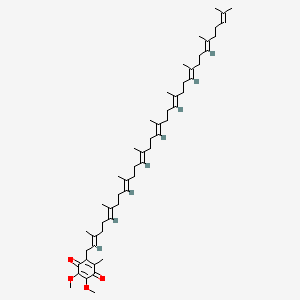| Authors | Title | Published | Journal | PubMed Link |
|---|---|---|---|---|
| Hauser E et al. | Pseudomonas psychrotolerans sp. nov. | 2004 | Int. J. Syst. Evol. Microbiol. | pmid:15388721 |
| Kucharská J et al. | Regeneration of coenzyme Q9 redox state and inhibition of oxidative stress by Rooibos tea (Aspalathus linearis) administration in carbon tetrachloride liver damage. | 2004 | Physiol Res | pmid:15479130 |
| Tang PH and deGrauw T | Redox cycling of coenzyme Q9 as a new measure of plasma reducing power. | 2004 | Clin. Chem. | pmid:15484328 |
| Jun L et al. | Identification and subcellular localization of two solanesyl diphosphate synthases from Arabidopsis thaliana. | 2004 | Plant Cell Physiol. | pmid:15653808 |
| Teshima K and Kondo T | Analytical method for ubiquinone-9 and ubiquinone-10 in rat tissues by liquid chromatography/turbo ion spray tandem mass spectrometry with 1-alkylamine as an additive to the mobile phase. | 2005 | Anal. Biochem. | pmid:15707930 |
| Baxter RH et al. | Cryogenic structure of the photosynthetic reaction center of Blastochloris viridis in the light and dark. | 2005 | Acta Crystallogr. D Biol. Crystallogr. | pmid:15858271 |
| Hermans N et al. | Method development and validation for monitoring in vivo oxidative stress: evaluation of lipid peroxidation and fat-soluble vitamin status by HPLC in rat plasma. | 2005 | J. Chromatogr. B Analyt. Technol. Biomed. Life Sci. | pmid:15990367 |
| Johnson A et al. | COQ9, a new gene required for the biosynthesis of coenzyme Q in Saccharomyces cerevisiae. | 2005 | J. Biol. Chem. | pmid:16027161 |
| Bello RI et al. | Enhanced anti-oxidant protection of liver membranes in long-lived rats fed on a coenzyme Q10-supplemented diet. | 2005 Aug-Sep | Exp. Gerontol. | pmid:16125350 |
| Novoselova EG | [Lipid metabolism in rat tissues during chronic gamma-irradiation and action of ubiquinone Q-9]. | 1992 | Biokhimiia | pmid:1637916 |
Coenzyme Q9
Coenzyme q9 is a lipid of Prenol Lipids (PR) class. The involved functions are known as Diastasis, Phosphorylation and Cardiac function.
Cross Reference
Introduction
To understand associated biological information of Coenzyme Q9, we collected biological information of abnormalities, associated pathways, cellular/molecular locations, biological functions, related genes/proteins, lipids and common seen animal/experimental models with organized paragraphs from literatures.
What diseases are associated with Coenzyme Q9?
There are no associated biomedical information in the current reference collection.
No disease MeSH terms mapped to the current reference collection.
PubChem Associated disorders and diseases
What pathways are associated with Coenzyme Q9
There are no associated biomedical information in the current reference collection.
PubChem Biomolecular Interactions and Pathways
Link to PubChem Biomolecular Interactions and PathwaysWhat cellular locations are associated with Coenzyme Q9?
There are no associated biomedical information in the current reference collection.
What functions are associated with Coenzyme Q9?
Related references are published most in these journals:
| Function | Cross reference | Weighted score | Related literatures |
|---|
What lipids are associated with Coenzyme Q9?
There are no associated biomedical information in the current reference collection.
What genes are associated with Coenzyme Q9?
There are no associated biomedical information in the current reference collection.
What common seen animal models are associated with Coenzyme Q9?
There are no associated biomedical information in the current reference collection.
